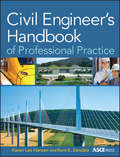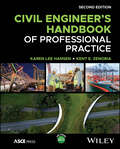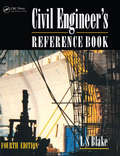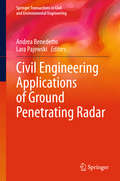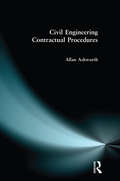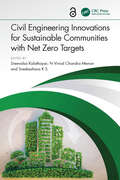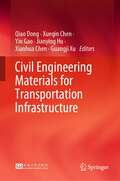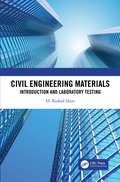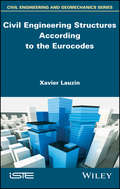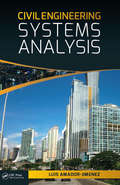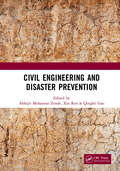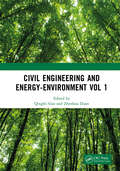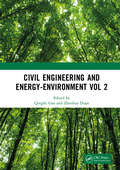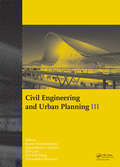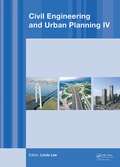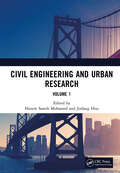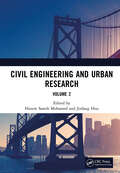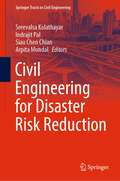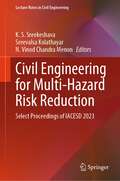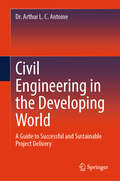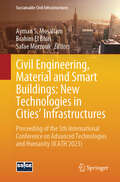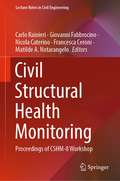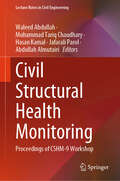- Table View
- List View
Civil Engineer's Handbook of Professional Practice
by Karen Lee Hansen Kent E. ZenobiaA well-written, hands-on, single-source guide to the professional practice of civil engineering There is a growing understanding that to be competitive at an international level, civil engineers not only must build on their traditional strengths in technology and science but also must acquire greater mastery of the business of civil engineering. Project management, teamwork, ethics, leadership, and communication have been defined as essential to the successful practice of civil engineering by the ASCE in the 2008 landmark publication, Civil Engineering Body of Knowledge for the 21st Century (BOK2). This single-source guide is the first to take the practical skills defined by the ASCE BOK2 and provide illuminating techniques, quotes, case examples, problems, and information to assist the reader in addressing the many challenges facing civil engineers in the real world. Civil Engineer's Handbook of Professional Practice: Focuses on the business and management aspects of a civil engineer's job, providing students and practitioners with sound business management principles Addresses contemporary issues such as permitting, globalization, sustainability, and emerging technologies Offers proven methods for balancing speed, quality, and price with contracting and legal issues in a client-oriented profession Includes guidance on juggling career goals, life outside work, compensation, and growth From the challenge of sustainability to the rigors of problem recognition and solving, this book is an essential tool for those practicing civil engineering.
Civil Engineer's Handbook of Professional Practice
by Karen Lee Hansen Kent E. ZenobiaA single-source guide to the professional practice of civil engineering Civil Engineer’s Handbook of Professional Practice, Second Edition assists students and practicing and professional engineers in addressing the many challenges they face. This guide expands on the practical skills defined by the American Society of Civil Engineers’ (ASCE’s) Civil Engineering Body of Knowledge (CEBOK) and provides illuminating techniques, quotes, example problems/solutions, case studies, and valuable information that engineers encounter in the real world. Including critical information on project management, leadership, and communication, this powerful resource distills the Accreditation Board for Science and Technology’s (ABET’s) requirements for a successful career and licensure. Due to the large amount of information that is presented in an easy-to-digest way, this handbook enables civil engineers to be competitive at an international level, building on their traditional strengths in technology and science while also providing the ability to master the business of civil engineering. In this second edition, readers will find: Modern business topics such as design thinking, affirmative action, equal opportunity and diversity, negotiation, health and safety requirements, construction management, body language interpretation skills, project management, and schedulingKey discussions of executing a professional commission, the engineer’s role in project development, professional engagement, and ethicsUpdated examples of everyday challenges for civil engineers, including defining the project, establishing objectives and innovative approaches, identifying resources and constraints, preparing a critical path schedule, quality control, and orchestrating project deliveryThe latest applications of emerging technologies, globalization impacts, and new sustainability applications for civil engineersExamples of a civil engineering request for proposal and corresponding workplan and feasibility study, technical report, specification, contracts, and scheduling and cost control tools Providing comprehensive coverage and in-depth guidance from leading industry and academic professionals, Civil Engineer’s Handbook of Professional Practice, Second Edition is a valuable reference for early-career and experienced civil engineers alike. It is also highly appropriate for upper-level undergraduate and graduate courses in Professional Practice and Engineering Project Management. Instructors have access to an instructor’s manual via the book’s companion website.
Civil Engineer's Reference Book
by L S BlakeAfter an examination of fundamental theories as applied to civil engineering, authoritative coverage is included on design practice for certain materials and specific structures and applications. A particular feature is the incorporation of chapters on construction and site practice, including contract management and control.
Civil Engineering Applications of Ground Penetrating Radar (Springer Transactions in Civil and Environmental Engineering)
by Andrea Benedetto Lara PajewskiThis book, based on Transport and Urban Development COST Action TU1208, presents the most advanced applications of ground penetrating radar (GPR) in a civil engineering context, with documentation of instrumentation, methods and results. It explains clearly how GPR can be employed for the surveying of critical transport infrastructure, such as roads, pavements, bridges and tunnels and for the sensing and mapping of underground utilities and voids. Detailed attention is also devoted to use of GPR in the inspection of geological structures and of construction materials and structures, including reinforced concrete, steel reinforcing bars and pre/post-tensioned stressing ducts. Advanced methods for solution of electromagnetic scattering problems and new data processing techniques are also presented. Readers will come to appreciate that GPR is a safe, advanced, non destructive and noninvasive imaging technique that can be effectively used for the inspection of composite structures and the performance of diagnostics relevant to the entire life cycle of civil engineering works.
Civil Engineering Contractual Procedures
by Allan AshworthCivil Engineering Contractual Procedures gives an introduction to the contractual procedures, legislation and administrative practices that are used in the civil engineering industry. It introduces the principles of contract law, and the main forms of contract used in the construction industry. It then concentrates on the main forms of contract used in civil engineering, with the discussion based on the ICE Conditions of Contract. It looks at the obligations of the various parties to the contract under all the clauses of the contract.Civil Engineering Contractual Procedures provides a sound basis for anyone seeking an understanding of the contractual administration of civil engineering projects. It is an essential core text for all students of civil engineering and related courses at both undergraduate and higher technician levels. It will also be a useful reference source for those already working in the industry.
Civil Engineering Innovations for Sustainable Communities with Net Zero Targets
by Sreevalsa Kolathayar N Vinod Chandra Menon Sreekeshava K SThis volume on civil engineering innovations for sustainable communities with net zero targets aligns with the United Nations sustainable development goals in the context of civil engineering innovations. Major topics covered include hydrological alterations under climate change, smart water management, sustainable slope stability solutions, sustainable water management and climate-smart agriculture, conservation of wetlands, influence of phase change materials on thermal properties, building information modeling (BIM) for sustainable and affordable construction, and so forth.Features: Combines concepts of civil engineering and sustainable development for future infrastructures Includes hydrological alterations under climate change impacts Covers prudent fiduciary discipline and effective cost management in the construction of buildings and critical infrastructure Discusses BIM and cost-effective sustainable construction Reviews hybrid artificial intelligence in civil infrastructure to attain SDGs #9 (industry, innovation and infrastructure) and #11 (sustainable cities and communities) This book is aimed at graduate students and researchers in civil engineering, sustainable development, risk management, GIS, and water.The Open Access version of this book, available at http://www.taylorfrancis.com, has been made available under a Creative Commons [Attribution-Non Commercial-No Derivatives (CC-BY-NC-ND)] 4.0 license.
Civil Engineering Materials for Transportation Infrastructure
by Xianhua Chen Jianying Hu Qiao Dong Xueqin Chen Yin Gao Guangji XuThis book aims to introduce the knowledge, tests, and designs of materials in civil engineering. The scope of this book includes the fundamental mechanical and physical properties of materials; properties, tests, and gradation designs of aggregates; production, composition, hydration, properties, and tests of lime and cement; composition, tests, and design of cement concrete; mechanisms, properties, and design of inorganic binder stabilized material; properties, tests, and grading of asphalt; composition, properties, tests, and designs of asphalt mixture; and properties, treatments, tests, and selections of steel. This book can be used as a textbook or a reference book for undergraduate students, graduate students, and professionals in the field of civil, pavement, bridge, geotechnical, and environmental engineering. In this book, many charts on the key properties are used to help explain the mechanisms of materials. Step-by-step examples are presented to help understand both the knowledge and practices of material design such as the aggregate gradation design, cement concrete design, asphalt grading, and asphalt mixture design. The tests, designs, and specifications of civil engineering materials in China are introduced in detail.
Civil Engineering Materials: Introduction and Laboratory Testing
by M. Rashad IslamCivil Engineering Materials: Introduction and Laboratory Testing discusses the properties, characterization procedures, and analysis techniques of primary civil engineering materials. It presents the latest design considerations and uses of engineering materials as well as theories for fully understanding them through numerous worked mathematical examples. The book also includes important laboratory tests which are clearly described in a step-by-step manner and further illustrated by high-quality figures. Also, analysis equations and their applications are presented with appropriate examples and relevant practice problems, including Fundamentals of Engineering (FE) styled questions as well those found on the American Concrete Institute (ACI) Concrete Field Testing Technician - Grade I certification exam. Features: Includes numerous worked examples to illustrate the theories presented Presents Fundamentals of Engineering (FE) examination sample questions in each chapter Reviews the ACI Concrete Field Testing Technician - Grade I certification exam Utilizes the latest laboratory testing standards and practices Includes additional resources for instructors teaching related courses This book is intended for students in civil engineering, construction engineering, civil engineering technology, construction management engineering technology, and construction management programs.
Civil Engineering Structures According to the Eurocodes: Inspection and Maintenance
by Xavier Lauzin"This standard assumes that the structure, after completion, is used as intended in the project and subject to planned inspection and maintenance to meet the expected project lifetime and to detect any unforeseen weakness or behavior" (EN 13670 §4.1) An important decision factor in the design of new structures and repairs to existing structures is the lifetime or expected service life. This concept, which is common for civil engineering works, has been extended to all engineering and building works by applying the European Structural Design Codes. This book tries to take stock of the inspection methodologies related to each type of civil engineering work, the various pathologies of concrete structures, and gives examples of the writing of reports.
Civil Engineering Systems Analysis
by Luis Amador-JimenezThis textbook covers tools and applications in civil engineering systems. It begins by revising the mathematical and statistical background for the adequate formulation of civil engineering problems. Then it examines a series of topics required to understand infrastructure, facilities and transportation networks, and their planning, maintenance, upgrading and expansion. It covers problem definition, model formulation and decision making systems, including optimization, estimation and prediction. The applications deal with some of the challenges that civil engineers will typically encounter during their professional lives, ranging from municipal planning and infrastructure management to transportation analysis. The treatment of the topics is integral. Tools and examples from real life situations are combined to illustrate the use of methods and principles. Students will learn to understand a system, conceptualize a model, analyse it and make decisions or draw conclusions, just as practising engineers do. A final chapter introduces methods for expanding simple models, adding complexity and incorporating uncertainty. Instructors can chose to cover some of the material from the foundation chapters on mathematics and statistics or directly concentrate on the tools and applications.
Civil Engineering Topics, Volume 4: Proceedings of the 29th IMAC, A Conference on Structural Dynamics, 2011
by Tom ProulxCivil Engineering Topics, Volume 4 Proceedings of the 29th IMAC, A Conference and Exposition on Structural Dynamics, 2011, the fourth volume of six from the Conference, brings together 35 contributions to this important area of research and engineering. The collection presents early findings and case studies on fundamental and applied aspects of Civil Engineering, including Operational Modal Analysis, Dynamic Behaviors and Structural Health Monitoring.
Civil Engineering and Disaster Prevention: Proceedings of the 4th International Conference on Civil, Architecture and Disaster Prevention and Control (CADPC 2023), Suzhou, China, 24-26 March 2023
by Xin Ren Qingfei Gao Abhijit Mohanrao ZendeCivil Engineering and Disaster Prevention focuses on the research of civil engineering, architecture and disaster prevention and control. These proceedings gather the most cutting-edge research and achievements, aiming to provide scholars and engineers with valuable research direction and engineering solutions. Subjects covered in the proceedings include: Civil Engineering Engineering Structure Architectural Materials Disaster Prevention and Control Building Electrical Engineering The works of these proceedings aim to promote the development of civil engineering and environment engineering. Thereby, fostering scientific information interchange between scholars from the top universities, research centers and high-tech enterprises working all around the world.
Civil Engineering and Energy-Environment Vol 1: Proceedings of the 4th International Conference on Civil Engineering, Environment Resources and Energy Materials (CCESEM 2022), Sanya, China, 21-23 October 2022
by Zhenhua Duan Qingfei GaoCivil Engineering and Energy-Environment focuses on the research of civil engineering, environment resources and energy materials. This proceedings gathers the most cutting-edge research and achievements, aiming to provide scholars and engineers with preferable research direction and engineering solution as reference. Subjects in this proceedings include: - Engineering Structure- Environmental Protection Materials- Architectural Environment ·Environment Resources- Energy Storage- Building Electrical Engineering The works of this proceedings will promote development of civil engineering and environment engineering. Thereby, promote scientific information interchange between scholars from top universities, research centers and high-tech enterprises working all around the world.
Civil Engineering and Energy-Environment Vol 2: Proceedings of the 4th International Conference on Civil Engineering, Environment Resources and Energy Materials (CCESEM 2022), Sanya, China, 21-23 October 2022
by Zhenhua Duan Qingfei GaoCivil Engineering and Energy-Environment focuses on the research of civil engineering, environment resources and energy materials. This proceedings gathers the most cutting-edge research and achievements, aiming to provide scholars and engineers with preferable research direction and engineering solution as reference. Subjects in this proceedings include: - Engineering Structure- Environmental Protection Materials- Architectural Environment ·Environment Resources- Energy Storage- Building Electrical Engineering The works of this proceedings will promote development of civil engineering and environment engineering. Thereby, promote scientific information interchange between scholars from top universities, research centers and high-tech enterprises working all around the world.
Civil Engineering and Urban Planning III
by Kouros Mohammadian Konstadinos G. Goulias Elif Cicek Jieh-Jiuh Wang Chrysanthos MaraveasCivil Engineering and Urban Planning III addresses civil engineering and urban planning issues associated with transportation and the environment. The contributions not only highlight current practices in these areas, but also pay attention to future research and applications, and provide an overview of the progress made in a wide variety of topics
Civil Engineering and Urban Planning IV: Proceedings of the 4th International Conference on Civil Engineering and Urban Planning, Beijing, China, 25-27 July 2015
by Yuan-Ming Liu Dong Fu Zhen-Xin Tong Bin Tang Zhi-Qing BaoxCivil Engineering and Urban Planning IV includes the papers presented at the 4th International Conference on Civil Engineering and Urban Planning (CEUP 2015, Beijing, China, 25-27 July 2015). The contributions from experts and world-renowned scientists cover a wide variety of topics: - Civil engineering;- Architecture and urban planning; - Transpor
Civil Engineering and Urban Research, Volume 1: Proceedings of the 4th International Conference on Civil Architecture and Urban Engineering (ICCAUE 2022), Xining, China, 24–26 June 2022
by Hazem Samih Mohamed Jinfang HouCivil Engineering and Urban Research collects papers resulting from the conference on Civil, Architecture and Urban Engineering (ICCAUE 2022), Xining, China, 24–26 June 2022. The primary goal is to promote research and developmental activities in civil engineering, architecture and urban research. Moreover, it aims to promote scientific information interchange between scholars from the top universities, business associations, research centers and high-tech enterprises working all around the world. The conference conducts in-depth exchanges and discussions on relevant topics such as civil engineering and architecture, aiming to provide an academic and technical communication platform for scholars and engineers engaged in scientific research and engineering practice in the field of urban engineering, civil engineering and architecture design. By sharing the research status of scientific research achievements and cutting-edge technologies, it helps scholars and engineers all over the world comprehend the academic development trend and broaden research ideas. So as to strengthen international academic research, academic topics exchange and discussion, and promote the industrialization cooperation of academic achievements.
Civil Engineering and Urban Research, Volume 2: Proceedings of the 4th International Conference on Civil Architecture and Urban Engineering (ICCAUE 2022), Xining, China, 24–26 June 2022
by Hazem Samih Mohamed Jinfang HouCivil Engineering and Urban Research collects papers resulting from the conference on Civil, Architecture and Urban Engineering (ICCAUE 2022), Xining, China, 24–26 June 2022. The primary goal is to promote research and developmental activities in civil engineering, architecture and urban research. Moreover, it aims to promote scientific information interchange between scholars from the top universities, business associations, research centers and high-tech enterprises working all around the world. The conference conducts in-depth exchanges and discussions on relevant topics such as civil engineering and architecture, aiming to provide an academic and technical communication platform for scholars and engineers engaged in scientific research and engineering practice in the field of urban engineering, civil engineering and architecture design. By sharing the research status of scientific research achievements and cutting-edge technologies, it helps scholars and engineers all over the world comprehend the academic development trend and broaden research ideas. So as to strengthen international academic research, academic topics exchange and discussion, and promote the industrialization cooperation of academic achievements.
Civil Engineering for Disaster Risk Reduction (Springer Tracts in Civil Engineering)
by Indrajit Pal Sreevalsa Kolathayar Siau Chen Chian Arpita MondalThe book is a comprehensive volume on multi-hazards and their management for a sustainable built environment. It focuses on the role of civil engineering in building disaster resilient society. This book brings together all diverse disciplines of civil engineering and related areas (for example, geotechnical engineering, water resources engineering, structural engineering, transportation engineering, environmental engineering, construction management, GIS, and remote sensing) towards a common goal of disaster resilience through an interdisciplinary approach. It contains methods and case studies focusing on civil engineering solutions to reduce the disaster risk. The book contents are aligned in line with the priorities set by UN-Sendai Framework for Disaster Risk Reduction and UN-SDGs to promote a global culture of risk-awareness and disaster reduction. The book will be a useful comprehensive reference for disaster risk reduction beneficial for engineering students, teaching faculty, researchers, industry professionals and policymakers.
Civil Engineering for Multi-Hazard Risk Reduction: Select Proceedings of IACESD 2023 (Lecture Notes in Civil Engineering #457)
by Sreevalsa Kolathayar N. Vinod Chandra Menon K. S. SreekeshavaThis book presents select proceedings of the International Conference on Interdisciplinary Approaches in Civil Engineering for Sustainable Development (IACESD 2023) hosted under the aegis of the Group of Twenty (G20) and Civil 20 (C20) at Jyothy Institute of Technology, Bengaluru, India. The topics covered include sustainable and resilient communities, sustainable construction materials, disaster resilient infrastructure, nano-composites and bio-composites, sustainable geotechnics and earthquake engineering. This book serves as a resource material for researchers and industry professionals interested in disaster risk reduction.
Civil Engineering in the Developing World: A Guide to Successful and Sustainable Project Delivery
by Dr. Arthur L. C. AntoineThis book provides a pragmatic roadmap for mastering project delivery in civil and infrastructure engineering—one that applies across both developing and industrialized nations. Dr. Arthur L.C. Antoine, an experienced civil engineer, project manager, and researcher, blends real-world case studies with empirical data to scrutinize current project delivery methods and performance. With a focus on the foundational pillars of schedule, cost, and quality—alongside the critical but often overlooked elements of procurement and risk—this book offers a fresh perspective for industry professionals, policymakers, and stakeholders. Through practical insights and rigorous analysis, Dr. Antoine challenges conventional approaches, highlights global best practices, and presents actionable recommendations for delivering infrastructure projects that are successfully delivered with a focus on long-term transformation. The book is ideal for engineers, project managers, public works leaders, and anyone invested in the future of infrastructure development.
Civil Engineering, Material and Smart Buildings: Proceeding of the 5th International Conference on Advanced Technologies and Humanity (ICATH'2023) (Sustainable Civil Infrastructures)
by Brahim El Bhiri Ayman S. Mosallam Safae MerzoukAs cities continue to grow and evolve, the challenges of building sustainable, resilient, and efficient urban environments have never been greater. This comprehensive volume presents cutting-edge research and innovative solutions in the fields of construction, materials science, and civil engineering. With contributions from leading experts and researchers, this book explores the transformative role of new technologies, sustainable materials, and advanced methodologies in shaping the future of cities worldwide. Part 1: New Ideas and Innovations in City Structures showcases groundbreaking research in areas such as manganese enrichment from mining tailings, the integration of machine learning in civil engineering, and the harmonious blend of mathematics and aesthetics in urban design through Moroccan and Andalusian tiling. These innovations push the boundaries of what’s possible in urban planning and construction, offering insights into the future of city development. Part 2: Construction and Materials delves into the practical applications and challenges of using sustainable materials like Ferrock concrete, recycled asphalt pavement, and fiber-reinforced polymers (FRP) for structural reinforcement. With a focus on durability and environmental impact, this section provides a thorough review of current best practices and emerging technologies that promise to revolutionize the construction industry. Part 3: Testing and Technologies in Urban Infrastructure highlights the latest testing techniques and technologies used to evaluate and improve the safety, efficiency, and sustainability of urban buildings and infrastructure. From seismic performance in reinforced concrete structures to the development of zero-energy buildings, this section offers a detailed analysis of the cutting-edge methods that are driving innovation in modern cityscapes. This book is an essential resource for professionals, researchers, and students in civil engineering, urban planning, and materials science. By exploring both theoretical concepts and real-world applications, " Civil Engineering, Material, and Smart Buildings: New Technologies in Cities' Infrastructures" provides valuable insights into the future of urban construction and the key technologies that will shape the cities of tomorrow.
Civil Liability and Financial Security for Offshore Oil and Gas Activities
by Michael FaureCivil Liability and Financial Security for Offshore Oil and Gas Activities provides insights into the liability and compensation regime for offshore-related damage. The book analyses the legal regime in a variety of states (including the US and the UK) as well as the EU regime. In addition, the various compensation mechanisms and amounts available today to compensate offshore-related damage are described and critically analysed. Moreover, the book is based on in-depth interviews with a wide variety of relevant stakeholders including insurers, representatives from supervisory authorities, and oil and gas producers. This volume also provides a variety of policy recommendations, formulated to provide an optimal compensation regime for offshore-related damage.
Civil Structural Health Monitoring: Proceedings of CSHM-8 Workshop (Lecture Notes in Civil Engineering #156)
by Carlo Rainieri Giovanni Fabbrocino Nicola Caterino Francesca Ceroni Matilde A. NotarangeloThis volume gathers the latest advances and innovations in the field of structural health monitoring, as presented at the 8th Civil Structural Health Monitoring Workshop (CSHM-8), held on March 31–April 2, 2021. It discusses emerging challenges in civil SHM and more broadly in the fields of smart materials and intelligent systems for civil engineering applications. The contributions cover a diverse range of topics, including applications of SHM to civil structures and infrastructures, innovative sensing solutions for SHM, data-driven damage detection techniques, nonlinear systems and analysis techniques, influence of environmental and operational conditions, aging structures and infrastructures in hazardous environments, and SHM in earthquake prone regions. Selected by means of a rigorous peer-review process, they will spur novel research directions and foster future multidisciplinary collaborations.
Civil Structural Health Monitoring: Proceedings of CSHM-9 Workshop (Lecture Notes in Civil Engineering #516)
by Waleed Abdullah Muhammad Tariq Chaudhary Hasan Kamal Jafarali Parol Abdullah AlmutairiThis book gathers the latest advances and innovations in the field of structural health monitoring, as presented at the 9th Civil Structural Health Monitoring Workshop (CSHM-9), held in Kuwait on February 12–14, 2024. It discusses emerging challenges in civil SHM and more broadly in the fields of smart materials and intelligent systems for civil engineering applications. The contributions cover a diverse range of topics, including applications of SHM to civil structures and infrastructures, innovative sensing solutions for SHM, data-driven damage detection techniques, nonlinear systems and analysis techniques, influence of environmental and operational conditions, aging structures and infrastructures in hazardous environments, and SHM in earthquake prone regions. Selected by means of a rigorous peer-review process, they will spur novel research directions and foster future multidisciplinary collaborations.
